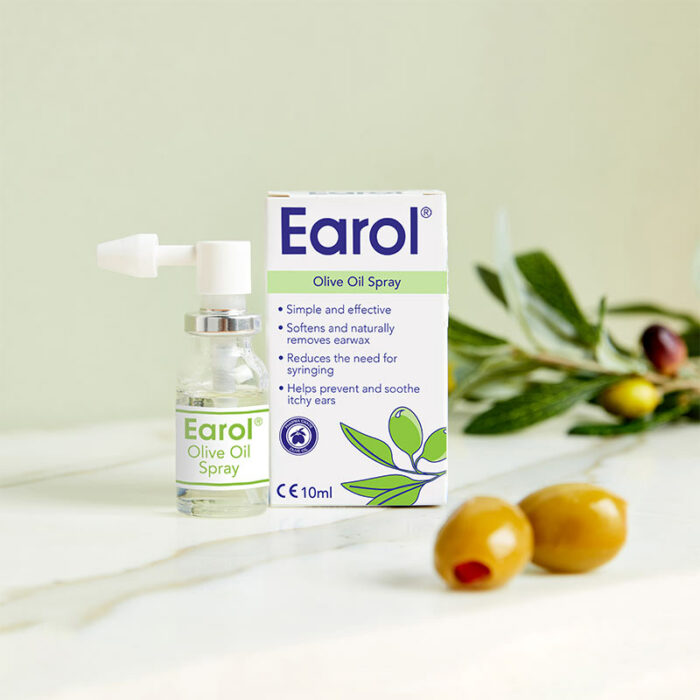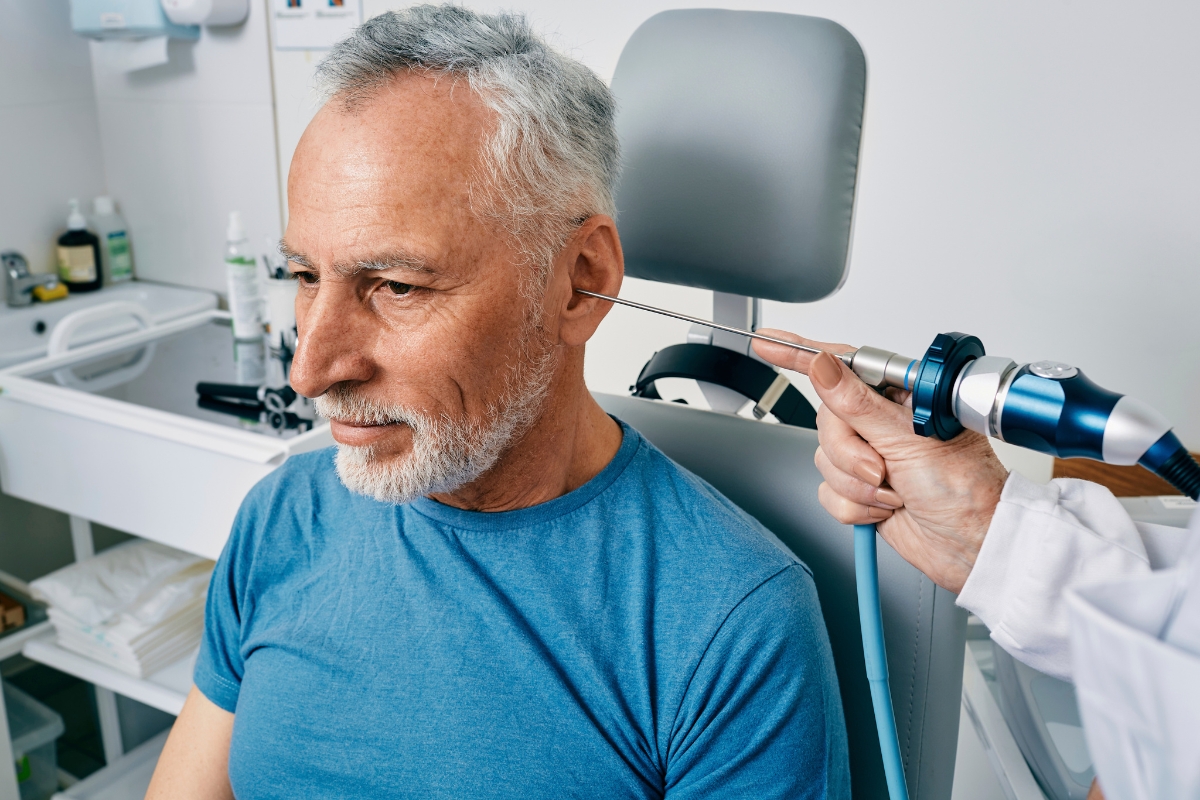The Safest Way to Remove Wax from Ears
Impacted ear wax build-up can be uncomfortable and painful, leading to difficulty hearing, earaches and even infections. It is important to remove impacted ear wax, but this needs to be done with caution. Many people are aware that using cotton buds to clean ears is counter-productive, as it pushes wax further into the ear canal and can make blockages worse. Earol spray is an effective, natural ear wax removal method that helps soften wax blockages so that it can leave the ear on its own.
In this article, we discuss what ear wax is for, how to remove wax in the ear safely and effectively, and when you should see a doctor.
What is Ear Wax?
Earwax is a yellow-to-brown waxy substance made inside the ears as part of their natural cleaning and defence system. The earwax is made by glands in the ear canal which produce a waxy oil known as Cerumen. This oil hydrates the skin of the ear canal and protects it against infection. It is largely made from keratin, cholesterol and long-chain fatty acids, and creates a barrier to protect the inner ear from water, dust, bacteria and even insects.
Cerumen traps dead skin cells, small amounts of hair and other substances, protecting the eardrum and inner ear. This mixture becomes the earwax we see, as it moves along the ear canal and falls out of the ear.
To sum up, Earwax is helpful to the ear because it:
- Traps dust, bacteria and small objects, preventing them from entering and damaging the ear
- Protects and hydrates the delicate skin of the ear canal, creating a barrier against water to prevent irritation
What Causes Ear Wax?
Ear wax is a mixture of dead skin cells, sweat, hair, dust and other debris and cerumen, a waxy oil produced by glands in the ear canal. As the skin of the ear canal grows towards the outer ear, ear wax is carried to the outside, where it hardens and falls out. The whole process takes approximately two weeks.
Sometimes there is more ear wax, for example, if your ears create more cerumen than others, or if your ears have been subject to a lot of dust and debris. If the earwax can not get out, it can harden inside the ear canal, causing a build-up and blockage.
How do you know if your ears are blocked?
Earwax Build-up or Impacted Earwax is an uncomfortable but common problem. Anyone can experience earwax build-up, but it is most common in older people and those using hearing aids, ear plugs or earbud earphones.
According to the BMJ, earwax build-up requiring removal affects about 2.3 million people/year in the UK, with the proportion rising to 44% among care home residents with dementia.1
Symptoms of Earwax Build-up
You may be suffering from impacted earwax or build-up if you experience these symptoms:
- hearing loss, sometimes as though your ears have ‘popped’
- earache or a blocked feeling in your ears
- ringing or buzzing in your ears (known as tinnitus)
- In some cases, vertigo (feeling dizzy and sick)
What Causes Earwax Build-Up?
An earwax build-up or impacted earwax may occur in anyone’s ear, but are more likely for people who have:
- Narrow or damaged ear canals
- Lots of hair in your ear canals
- A skin condition affecting your scalp or around your ear, such as seborrheic dermatitis
- Inflammation of your ear canal, caused by bacterial infection such as otitis externa or “swimmer’s ear”
- Putting things into the ear canal repeatedly over time, such as cotton buds, in-ear headphones, hearing aids or ear plugs.
It is not possible to prevent earwax from being made at all, as it is part of the ear’s natural defences. However, it is possible to prevent earwax build-up by regularly softening the earwax that is made, particularly if hearing aids or earphones may be stopping the wax from coming out on its own.
How Often Should You Clean Your Ears?
Like most mammals, human ears are self-cleaning and earwax usually falls out on its own, particularly when you lie on your side. It is estimated to take approximately two weeks for earwax to make its way out of your ear canal completely.
Experts recommend cleaning your ears every two to four weeks, if at all. Washing your ears too frequently can strip the ear of its protective lining, which is there to stop bacteria from entering the skin and multiplying, causing infection.
If you wear earplugs, hearing aids or in-ear headphones, you are more likely to need to clean your ears occasionally. Read on to find out how to do this safely.
What Is The Safest Way To Clean Wax From Ears:
Your ears house complex and delicate systems. Like your eyes and other areas, the ears can clean themselves if looked after. Cleaning your ears incorrectly, too frequently or with anything harsh can be counter-productive. In this section of the article we will discuss cleaning wax from ears safely.

How to Remove Ear Wax at home: What to do
There are plenty of natural ways to remove ear wax at home. These methods are the best ways to clean wax from the ears.
- Gently clean the outer ear with a damp cloth
- Try to soften the earwax with a mild ear spray, drops or solution for a few days
- Use Olive Oil for Ears
Applying a small amount of gently warmed olive oil (1-2 drops) to the ear canal and allowing it to sit is a natural and effective way of softening and removing wax from ears. (It’s also great for your skin!) - Use a Mild Ear Wax Spray
- Use Olive Oil for Ears
Earol Spray contains fine pharmaceutical-grade olive oil in a simple spray bottle designed for ears. This is much more accessible than using the oil in your kitchen, as Earol is thinner, colourless, odourless and easy to store.
- Move your jaw to create a gentle movement within the ear that can help earwax move
- Be Patient. It may take up to 5 days of using eardrops or ear wax spray before the blockage clears itself.
- Avoid using in-ear headphones or earplugs until the blockage has cleared.
How Not To Clean Your Ears: What Not to Do
- Don’t poke anything into your ear canal (such as cotton buds, fingers, etc.)
While it seems intuitive to scoop out excess wax from your ears with a cotton bud or anything else, this isn’t a safe method. While you might get some wax out, you’re likely to push more wax further into the ear and scrape protective coatings from the skin. This leads to earwax blockages and further issues.
- Don’t clean your ears too frequently
Because they are self-cleaning organs, cleaning your ears more than every two weeks can damage the delicate lining that protects your ears from bacterial infection, and make them less effective at allowing earwax to fall out naturally.
- Avoid using ear candles
- This practice of lighting a hollow candle in the ear to suck stubborn wax away is ineffective at best and dangerous at worst.
- Seek Medical Supervision if you have a perforated eardrum for any ear spray use
- Do not use Earol or any other ear spray for children under 12 months of age.
How To Remove Ear Wax Safely With Earol Spray
Earol spray provides the best method for ear wax removal in a simple system. This is a medical-grade olive oil spray for ears that is easy to use. This earwax removal spray is safe to use for adults and children older than 1 year.
- Gently warm the bottle in the palm of your hand by rolling it back and forth a few times. The warmth will assist in softening the ear wax build-up.
- Shake well to ensure the oil is well distributed.
- Pull the upper ear upwards and backwards
- Place the nozzle at the entrance to the ear canal while holding the bottle upright
- Press the spray actuator down fully 1-2 times. If it’s the first time you are using the bottle, you may need to press it 3-4 times to draw the oil up the tube. You should feel a gentle spray inside your ear canal.
- Gently massage the tragus (the part of your ear which can cover the ear canal if pressed). This helps the olive oil spray to mix with the ear wax, softening it for removal.
- Repeat on the other ear if needed.
- Clean the nozzle after use. Remove the plastic cone from the spray mechanism by gently pulling. Rinse with hot water and replace.
Adults and Children over 12 can continue to use Earol olive oil spray
When Should I Visit a Doctor for Earwax Build-Up?
Earol Olive Oil Spray is safe to use at home and can help an earwax blockage to clear. However, if you have a perforated eardrum, or if the blockage is severe, you should visit a doctor or nurse at your GP practice and request an ear wax removal procedure.
See a nurse at your GP practice if:
- your symptoms have not cleared after 5 days of using Earol spray.
- your ear is badly blocked and you cannot hear at all in that ear. It may be infected and require medical attention.
- You experience symptoms of an allergic reaction, such as a rash or swelling
- You experience signs of infection, such as a reddening of the skin of the ear, your ear getting very hot, or a discharge of any clear or white liquid.
For Adults and Children over 12: Continue to apply Earol twice daily for 4-5 days before consultation for ear wax removal or syringing by a GP or audiologist. Your audiologist or GP may recommend using Earol once a week to prevent earwax build-up in future.
Earol Olive Oil Spray is a Safe Method of Ear Wax Removal At Home
This simple, natural and effective method of softening or naturally removing earwax reduces the need for syringing. It can also be used to facilitate ear syringing if necessary. Consult your pharmacist or doctor about using Earol spray to soften and remove ear wax.
References
1 Munro K. J. et al. ‘Ear wax management in primary care: what the busy GP needs to know’ in British Journal of General Practice, 2023, Vol 73 (727), pp. 90-92, DOI:





